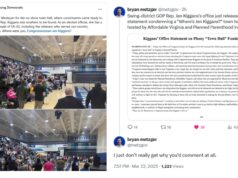I’ve written previously about my strong support for Instant Runoff Voting (IRV)/Ranked Choice Voting (RCV). I quoted DPVA Vice Chair Dave Leichtman on why this makes so much sense:
Preference balloting enables what’s called an “Instant Runoff.” Normally, in a single-election election, if you require the winner to achieve a majority of votes (as opposed to the commonly used plurality) and nobody does, it’s necessary to call a second runoff election. Asking people to vote twice incurs more costs, more voter fatigue, and reduces turnout. But if you allow voters to specify who their vote would go to in the event of a runoff, you enable an instant runoff. You can determine who gets a majority by reallocating the second-preference votes for voters whose candidates were eliminated in earlier rounds of balloting.
This is, in essence, more “free and fair.” Asking that a winning candidate receive a majority (or at least, in this case, a majority of preference votes), helps unify voters behind that candidate through investiture. It also simply increases the number of people who produced the result – a critical component when you consider that in a place like Arlington, the Democratic primary is likely to decide the general election.
Also, as former Arlington Dems Chair Kip Malinosky argues, “In Arlington, we implemented instant runoff voting for our caucuses to ensure that each candidate had a strong incentive to reach beyond his or her base.” Anyway, for a wide variety of reasons, I join Dave and Kip (and many others) in supporting IRV/RCV.
Currently, Virginia doesn’t allow IRV/RCV in primaries. But let’s say IRV/RCV had been in place for Virginia primaries on June 11, 2019. How might that have changed the results? As far as I can determine, not many were likely to change, but a couple big ones could have. See below for a list or Democratic primaries with more than two candidates, and which ones I think might have changed with IRV/RCV.
- SD7 had three Democratic candidates, but Cheryl Turpin won with 58.8% of the vote, so IRV/RCV wouldn’t have made any difference at all.
- SD10 had three Democratic candidates, with Ghazala Hashmi getting close to 50% of the vote (she ended up with 49.4%). So, unless almost every single second-choice vote from Zachary Brown voters went to Eileen Bedell – an extremely unlikely scenario – Hashmi still would have won.
- SD35 had three Democratic candidates, with Dick Saslaw getting 48.63% of the vote, followed by Yasmine Taeb with 45.75% and Karen Torrent with 5.62%. For Taeb to have won, 4.26% of Torrent’s 5.62% share of the vote would have had to have been reallocated to Taeb. Is that possible? Given that Torrent was basically running on a single issue, opposition to Dominion Energy, it seems possible that would have happened. Regardless, it would have been VERY close; not sure whether Saslaw or Taeb would have won.
- HD87 had four Democratic candidates, with Suhas Subramanyam winning 47.23% of the vote. That put Subramanyam ahead of the second-place finisher, Hassan Ahmad, by 24 points. So…no, IRV/RCV wouldn’t have changed this result in this primary.
- HD96 had three Democratic candidates, with Mark Downey receiving 53.69% of the vote. Again, IRV/RCV wouldn’t have changed the result in this one.
- The Fairfax County Board Chair Democratic primary saw Jeff McKay win with 42.45% of the vote, followed by Alicia Plerhoples with 31.41%, Ryan McElveen with 16.35% and Tim Chapman with 9.79%. So Chapman would have been eliminated first, and presumably almost none of his votes would have gone to McKay, since Chapman’s candidacy was basically the anti-McKay candidacy. So Chapman’s votes would have been reallocated to Plerhoples and McElveen. Then, McElveen would have been eliminated, and his votes would have been reallocated. But to whom? I’m thinking more would have gone to Plerhoples, given that McElveen ran a very progressive campaign – as did Plerhoples – but that’s just speculation. But if, let’s say, McElveen had about 21% at that point, and Plerhoples had about 37%, then Plerhoples would have had to have grabbed nearly two-thirds of McElveen’s votes to hit 50%. Is it possible that could have happened? IMHO, yes, but we’ll never know at this point…
- The Hunter Mill (Fairfax County) Supervisor Democratic primary saw Walter Alcorn nearly hit 50% (he got 47.15%) in a five-person field, so…nope, zero chance anyone else could have overtaken him with IRV/RCV.
- Same thing in the Lee District (Fairfax County) Supervisor Democratic primary, where Rodney Lusk ran away with it against three other candidates.
- In the Providence District (Fairfax County) Supervisor Democratic primary, Dalia Palchik ended up winning with 39.78% of the vote, followed by Phil Niedzelski-Eichner at 23.40%, Erika Yalowitz at 13.97%, Edythe Kelleher at 12.73% and Linh Hoang at 10.11%. In theory, someone else could have overtaken Palchik, but I’m not sure why that would have been the case, as Hoang’s, Kelleher’s and Niedzelski-Eichner’s second-place votes presumably would have been scattered among the other candidates, including Palchik. So…no, I don’t think that IRV/RCV would have changed this one.
Any I missed? Let us know in the comments section.
P.S. One could also look at the Fairfax County Democratic Committee’s endorsement process for School Board, particularly the at-large race, where it’s possible that Ilryong Moon might have won in a four-candidate field if there had been IRV/RCV.



 Sign up for the Blue Virginia weekly newsletter
Sign up for the Blue Virginia weekly newsletter








